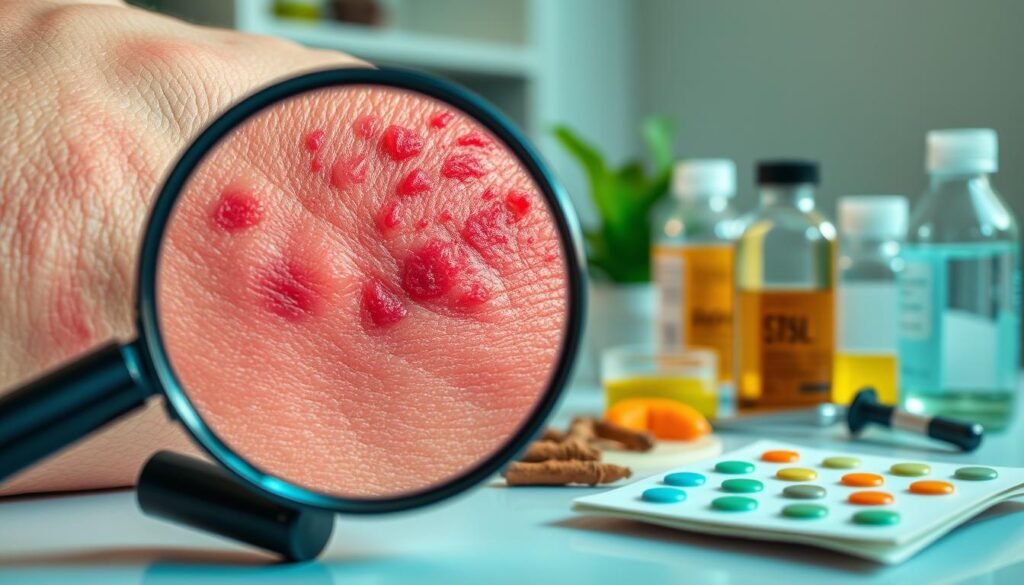Did you know? Every year, out of 100,000 workers, 1,700 face occupational contact dermatitis. This fact shows why it’s crucial to know and diagnose this skin issue. It mostly hits people in jobs like healthcare and making things. Finding out what causes contact dermatitis is key to handling it well.
The steps to diagnose contact dermatitis help not just in treating it right away. They also prevent it from coming back. This way, patients can enjoy a better life.
Key Takeaways
- The prevalence of contact dermatitis among workers emphasizes the need for awareness.
- Identifying the cause is essential for effective management.
- Common symptoms include itchy rashes that can last for weeks.
- Occupational exposure is a significant risk factor for developing contact dermatitis.
- Preventative strategies are vital in avoiding future episodes.
Understanding Contact Dermatitis
Contact dermatitis is common and shows up when skin meets irritants or allergens. This causes inflammation, leading to symptoms like itching and redness. Knowing about contact dermatitis types can help manage it better, improving life quality.
Definition and Types of Contact Dermatitis
There are two main types of contact dermatitis: allergic and irritant. Allergic type happens when skin responds to allergens like nickel or certain cosmetics. Symptoms might show up between 12 to 48 hours after contact. However, they sometimes take weeks to appear. Irritant type is more common, caused by long-term exposure to things like soaps or chemicals. It makes up about 80 percent of cases. Recognizing everyday product triggers is key to prevention.
Common Symptoms
Symptoms vary but often include:
- Redness
- Itching and discomfort
- Swelling
- Blisters on the skin
- Cracked or dry skin
Mostly, hands and face get affected. Knowing these symptoms helps in getting timely help. Also, frequent use of a product can lead to skin allergies. It’s crucial to watch out for skin reactions closely.
Identifying Potential Triggers
Figuring out what triggers contact dermatitis is key to managing it well. It helps to know the common irritants and allergens around us. Items like soaps, lotions, and chemicals often cause skin irritation.
Many people are allergic to materials like nickel in jewelry or certain scents. These can be major triggers.
Common Irritants and Allergens
Knowing different irritants and allergens is important for those with contact dermatitis. Here are some usual triggers:
- Nickel and chrome from jewelry and metal items
- Paraphenylenediamine in permanent hair dyes
- Neomycin, often found in antibiotic creams
- Fragrances in skincare and household products
- Latex rubber found in gloves and condoms
- Poison ivy and poison oak, especially among those who engage in outdoor activities
Patient History and Lifestyle Considerations
Reviewing a patient’s history is crucial for finding allergens. Doctors look at lifestyle factors in contact dermatitis cases. They consider things like:
- Occupation: Exposure to specific chemicals or substances in the workplace.
- Hobbies: Activities that may involve skin contact with irritants or allergens.
- Family history of skin conditions: Genetic predisposition to certain allergies.
- Daily habits: Use of skincare, haircare products, and other personal items.
By understanding these lifestyle aspects, healthcare professionals can offer better advice. They help people avoid things that irritate their skin.

Initial Consultation with a Healthcare Provider
The first visit to a healthcare provider is key to understanding contact dermatitis. Patients will talk in detail about their symptoms and medical history. This helps diagnose skin allergies accurately. This appointment is the first step towards evaluating and treating the condition.
What to Expect During the Visit
A detailed check-up happens during the dermatologist visit. The healthcare provider will ask about:
- When the symptoms started
- Any known allergies, including those related to environment or products
- The types of products recently used
- Occupational exposures to potential allergens
Bringing information about symptoms helps the provider. It leads to a clear path in identifying and handling contact dermatitis.
Questions Asked by the Healthcare Provider
The healthcare professional will ask key questions. They’ll want to know about:
- Recent changes in products used, like skincare or laundry detergent
- Family history of allergies
- Past similar reactions
- Connection between work and symptoms
These questions help find the cause of the allergy or irritation. The first visit shapes the next steps, making diagnosis more precise.

Skin Examination for Contact Dermatitis Diagnosis
Identifying skin rashes starts with a thorough examination. Healthcare providers perform a detailed visual check. They look for features that suggest contact dermatitis. This is vital for choosing the right treatment.
Visual Assessment by the Provider
Providers look at the rash’s color, shape, and where it appears on the skin. Each detail is key in finding what caused the rash. They search for signs like blisters, scales, or redness. These signs often point to allergic contact dermatitis.
Understanding the Appearance of the Rash
Knowing how contact dermatitis looks helps providers tell it apart from other skin issues. It can look similar to eczema, which makes diagnosis tricky. Recognizing the features of the rash aids in creating a personalized treatment plan. For detailed info on diagnosing allergic contact dermatitis, check out this resource.
Step-by-Step Process of Diagnosing Contact Dermatitis
Finding out if someone has contact dermatitis is important. It helps figure out what causes skin reactions. Doctors follow steps to help patients understand and deal with their symptoms.
Importance of Accurate Diagnosis
Getting the diagnosis right is key to avoid treatments that don’t work. Doctors look at your medical history and symptoms closely. They might do special skin tests. This helps them be sure about what’s causing the problem. This info also helps when dealing with insurance.
Potential Follow-up Referrals
Sometimes, the first tests don’t give clear answers. Then, seeing a specialist for dermatitis is needed. Places like the Park Nicollet Contact Dermatitis Clinic are experts in this. They do detailed tests to get answers. Patients often come to them after seeing other skin doctors or allergists. This team effort helps find the right treatment.

| Step | Description |
|---|---|
| Initial Consultation | Patient provides medical and personal history relevant to allergy triggers. |
| Skin Examination | Healthcare provider visually assesses the rash and associated symptoms. |
| Patch Testing | Allergens are applied to the skin, with final evaluations occurring after eight days. |
| Follow-Up | Referrals may be made for further evaluation if the diagnosis remains unclear. |
If you want to know more about diagnosing contact dermatitis, talk to your doctor. You can also look at specialized resources. The Park Nicollet Contact Dermatitis Clinic is a great place for detailed info.
Allergy Patch Testing
Allergy patch testing is key in finding out what causes skin allergies. It uses hypoallergenic tape to apply small allergen amounts to the skin, mainly on the back. This allows doctors to see how the skin reacts.
Overview of the Patch Test Procedure
The testing involves putting 30 to 100 allergens on the skin at once. A standard test picks up about 70% of contact dermatitis cases. It’s not just about current skin issues. Positive results can also reveal past allergies and hint at future ones.
Expect several visits to check reactions over days. Staying committed to this process is crucial for an accurate diagnosis.
Duration and Commitment Required
The patch test takes about a week and requires your full cooperation. Before the test, you must avoid certain things like topical steroids and sun exposure. This ensures the test works best. Reactions differ, from mild redness to blisters.
Understanding eczema’s stages helps see how patch testing plays a role in managing skin problems. Learn more about eczema stages.
Allergy patch testing is crucial for spotting delayed allergic reactions, also known as type IV hypersensitivity. Even if results are negative, they’re still helpful. They guide the creation of a detailed treatment plan. This highlights the importance of patch testing in avoiding future allergic reactions.
Assessment of Patch Test Results
After the allergy patch testing, healthcare workers start to examine the results. This is crucial to find any allergic reactions. The check-up happens on the second and fifth days after the test. They use a scale to measure the severity of reactions.
This process helps in making smart choices about what to avoid in the future. The Thin-Layer Rapid Use Epicutaneous Test (TRUE Test) came out in 1995. It tests for 23 allergens and has one control spot. By 2007, it included five more allergens. Interestingly, 80% of skin inflammation is due to irritant contact dermatitis. Only 20% is from allergic contact dermatitis. This shows how complex skin reactions can be.
A survey in 1990 found that 27% did not use patch testing. And 54% tested less than one patient a week. But by 1997, 83% of skin doctors were using patch tests. This shows how allergy diagnosis has grown. The TRUE Test is expanding. It plans to test for 35 allergens soon.
Patch tests look for reactions after 48 and 72 hours. But, results are usually shared in 1-2 weeks. Dr. Rishi from Parashar Skin Clinic advises against swimming. Or using oily lotions near the test spot. These can change the test results.
| Type of Test | Duration | Common Allergens Tested |
|---|---|---|
| Patch Test | 1-2 weeks for results | Nickel, fragrances, hair dyes |
| Skin Prick Test | 3-5 minutes per allergen | Pollen, dust, pet dander |
| Blood Test | About 10 minutes | Bacterial and fungal allergens |
| Oral Challenge Test | 3-4 hours | Food allergens |
These tests help in making plans to manage skin allergies. They let patients understand their allergies better. This way, they can avoid allergens more easily.
For more info on the science behind skin allergies, check detailed guides. They explain testing and its effects on life. This helps doctors give the best care.
Learn more about the historical development of patch tests
Customized Treatment Plans
After figuring out someone has contact dermatitis, doctors can make treatment plans just for them. They focus on avoiding things that trigger allergies. This might mean using different products that are safe.
Keeping skin healthy in the long run is key. These plans relieve symptoms now and prevent problems later. It’s all about finding what works for the person.
Strategies to Avoid Trigger Substances
A big part of treating contact dermatitis is avoiding triggers. Patients should track what irritates their skin. This could be soaps, detergents, or even smoke.
Doctors often recommend safer products without allergens. This helps patients avoid things that cause flare-ups. It leads to healthier skin.
Recommendations for Skin Care Products
Doctors usually suggest skin care products made for sensitive skin. For tough cases, they might recommend special shampoos. These can have ingredients like selenium sulfide or coal tar.
They also look into options like vitamin D, probiotics, or herbal treatments. Practices like diluted bleach baths may help. It shows how complex caring for contact dermatitis can be.